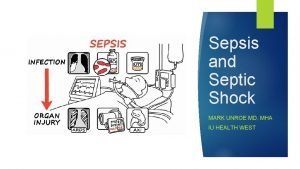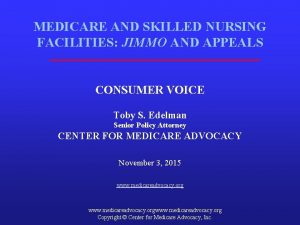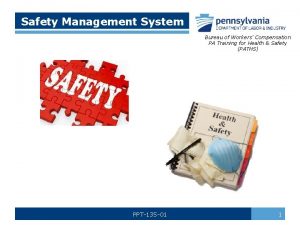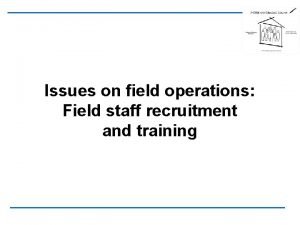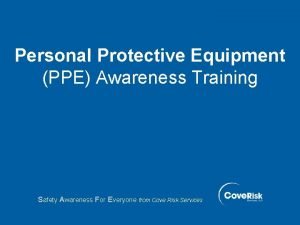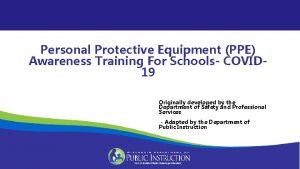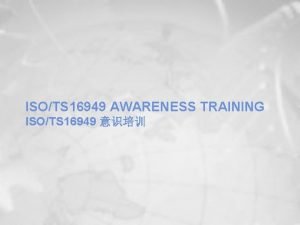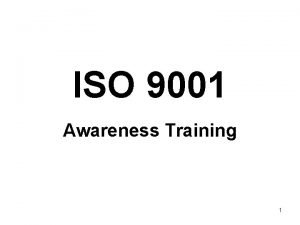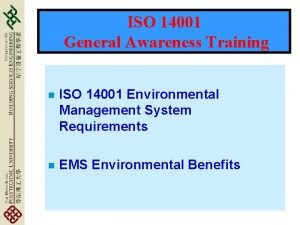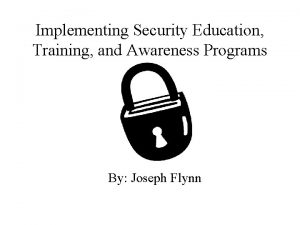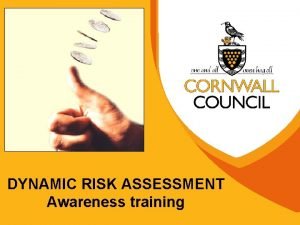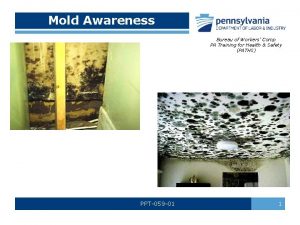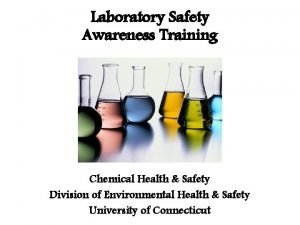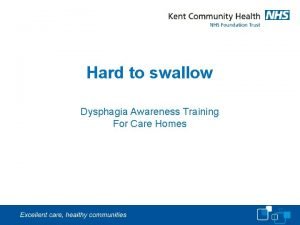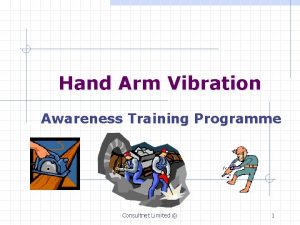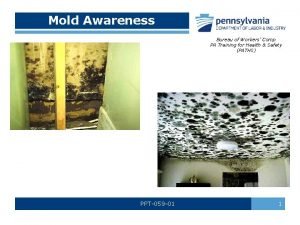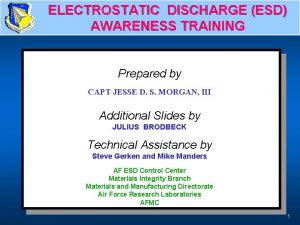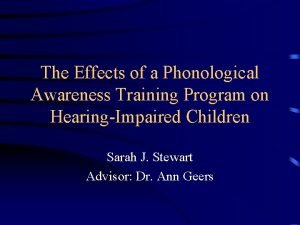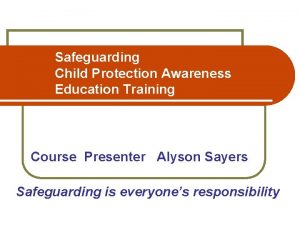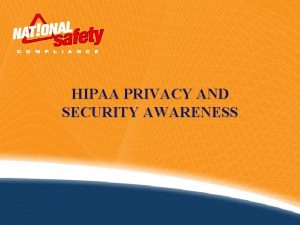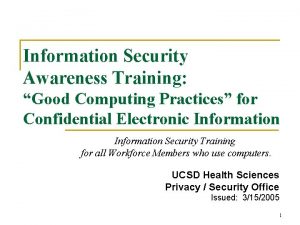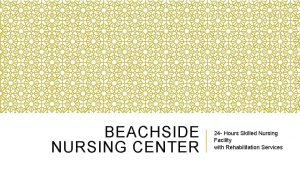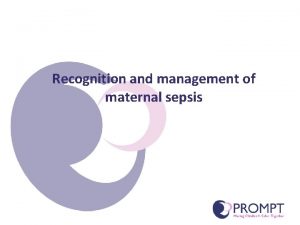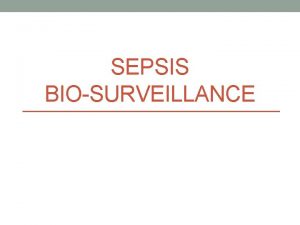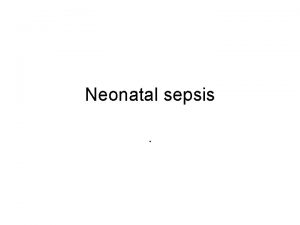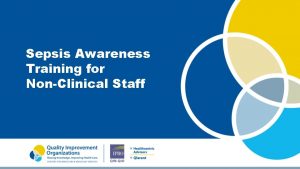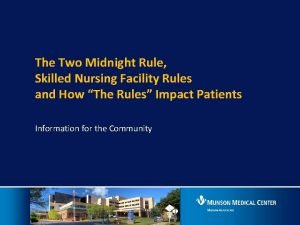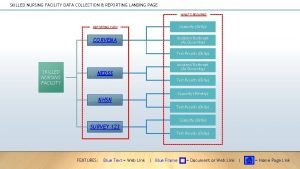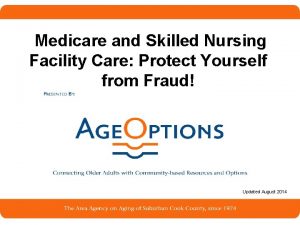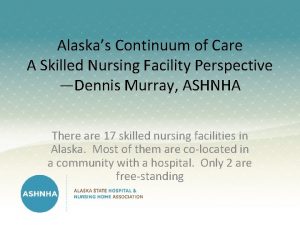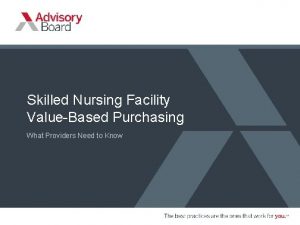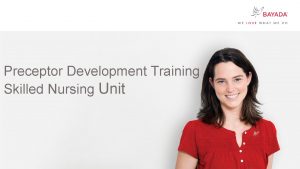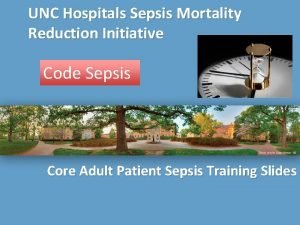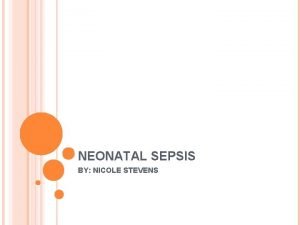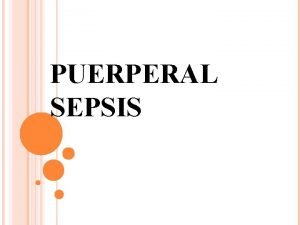Sepsis Awareness Training Skilled Nursing Facility Clinical Staff

















































- Slides: 49

Sepsis Awareness Training Skilled Nursing Facility Clinical Staff 03/2021

Please complete the Pre Training Assessment questions prior to the start of the training session Thank you! 2

Sepsis Training Content Outline § Sepsis Alliance video “SEPSIS: EMERGENCY” § Identification of high risk populations § Evidence supporting community based sepsis awareness § § § § Recognizing early signs/symptoms Treatment strategies SNF Care Pathway Sepsis Self Management Tool Post sepsis syndrome Preventative measures Facility based training process 3

CDC Get Ahead of Sepsis Campaign https: //www. youtube. com/watch? v=5 Jv. Gi. AFLels 4

Why This is Important… About Sepsis Alliance was created to raise sepsis awareness among both the general public and healthcare professionals. Sepsis awareness can and does save lives, yet only 58% of American adults have ever heard the word. Sepsis Alliance gives a voice to the millions of people who have been touched by sepsis – to the survivors, and the friends and family members of those who have survived or who have died. SEPSIS: EMERGENCY VIDEO Sepsis: Emergency Video Available on Sepsis Alliance Website: https: //www. sepsis. org 5

Sepsis: Emergency Video Cut and paste this URL into your browser https: //www. youtube. com/watch? v=Dns. Q 4 Rl. Xs. ZY 6

Sepsis is a life threatening condition that arises when the body’s response to an infection injures its own 1 tissues and organs Sepsis is a leading cause of death and healthcare spending globally 2, 3 1. Singer, et al. JAMA 2016; 315(8) 801 -810 2. Fleischmann, et al. Am J Resp Crit Care Med. 2016; 193: 259 -272 3. Iwashyna, et al. J Am Geriatr Soc. 2012; 60: 1070 -1077 7

Sepsis and Infection § Sepsis is always triggered by an infection § Sometimes people don’t know they have an infection § Sometimes the causative agent of the infection is not identified § Sepsis diagnosis is sometimes missed due to various manifestations of sepsis § Conversely: If symptoms of sepsis exist, a source of infection should be sought 8

Sepsis 9

Relevance to SNFs § Skilled Nursing Facility providers treat and care for populations most vulnerable to sepsis § Skilled Nursing Providers are a critical link to preventing, recognizing, and treating sepsis § Early identification of sepsis in the SNF care setting will promote rapid treatment response either in house or referral to the next level of care § Targeting sepsis as a public health concern, addresses major factors affecting: Quality of healthcare, potentially avoidable hospitalizations and cost 10

Early Signs of Sepsis always develops from an *infection with more than one of the following: § § § § § Fever, shivering, feeling very cold Cool extremities or mottling of skin Rapid heart rate Rapid breathing Shortness of breath Confusion or difficult to arouse Complaints of extreme pain Pale/discolored skin Clammy sweaty skin * Confirmed or suspected 11

Other Early Signs May Include… § Decreased blood pressure § (SBP <90 mm. Hg or SBP decrease>40 mm. Hg) § § Other signs of altered mental status § Abnormal lab tests Decreased urine output / dark, concentrated urine § Increased lactate level § Increased creatinine § Decreased platelet count § Coagulation abnormalities § Hyperglycemia in absence of diabetes 12

Early Recognition is Important Early detection and treatment is critical to: § Decrease morbidity and mortality related to sepsis § Avoid long term health-related complications § Potentially avoiding sepsis-related hospitalizations We have a great opportunity to educate patients, family, friends and co-workers Your prompt actions could save a life! 13

If Not Treated Promptly… Sepsis can result in: § Organ Failure § Tissue Damage § Death 14

Who is at Risk for Sepsis? Anyone with an infection! Those at higher risk for developing sepsis include: § § § § People 65 or older Infants less than 1 year old People with chronic illnesses: diabetes, cancer, AIDS People with weakened immune systems People recently hospitalized People recovering from surgery People who have had sepsis in the past 15

Time to Treatment is Critical § Mortality increases by 8% for every hour that appropriate treatment is delayed § Early identification and treatment are the keys to improved outcomes 16

Common Infectious Diseases That May Progress to Sepsis § § § § Pneumonia Skin Infections (cellulitis) Urinary Tract Infections Post-partum Endometritis Influenza Clostridium difficile (C. diff) Enteritis Tick-borne Infections especially in the immunocompromised 17

Famous People Who Have Died From Sepsis § § § Mother Theresa Pope John Paul II Patty Duke (actor) Christopher Reeve (actor) Mohammed Ali (boxer) Jim Henson (Muppets creator) § Casey Kasem (radio personality) § § § Chuck Brown (singer) Marty Allen (comedian) Robin Gibb (singer) Lawrence Welk (musician) Anna Nicole Smith (model) § Leslie Nielson (actor) § Prince Ranier of Monaco 18

Why Community Based? § > 80% of sepsis cases originate in the community § Sepsis mortality is largely preventable with early detection and appropriate treatment § Just 58% of U. S. adults have heard of sepsis § Sepsis diagnosis often missed by healthcare providers § Sepsis is the #1 reason for 30 -day hospital readmissions 19

42% of Americans Have Never Heard of Sepsis 42% 1. http: //www. sepsisalliance. org/news/2013/four_in_ten_adults_never_heard_of_sepsis

Public Awareness is Poor § Sepsis is one of the most under recognized and misunderstood conditions by HCPs and the public § The public needs an understandable definition of sepsis § Healthcare providers need improved clinical prompts to facilitate earlier identification of sepsis 21

Sobering Statistics The word sepsis was 1 st introduced by Hippocrates (460 -370 BC), derived from the Greek word sepsi, meaning to “make rotten” 1 § Mortality rate for severe sepsis is 29% which is greater than: § § § 2 § AMI (25%) § Stroke (23%) § Trauma (1. 5%) 3 4 18 million people die of sepsis worldwide every year Sepsis is the leading cause of childhood deaths Sepsis is the most expensive condition treated in U. S. hospitals Sepsis kills 258, 000 Americans annually 5 6 Early diagnosis of sepsis is often missed 1. JACC 1996 2. American Heart Association. Heart Disease and Stroke Statistics- 2005 Update 3. Crit Care Med 2001 4. National Highway Traffic Safety Administration. Traffic Safety Facts 2003 5. AHRQ 6. CDC 22

Approach Educate on the premise that Sepsis is a Medical Emergency § Improve sepsis care transitions between pre-hospital, acute care and post-acute healthcare and community settings § Focus education on high risk populations and the community § Educate physicians on early recognition of sepsis in the outpatient setting 1. (Singer, et al. JAMA 2016; 315(8) 801 -810) 23

24

2012 Definitions for Sepsis Systemic Inflammatory Response Syndrome (SIRS) SIRS is nonspecific and can be caused by: infection, inflammation, trauma, ischemia or several insults combined SEPSIS = INFECTION + 2 OR MORE SIRS CRITERIA SIRS Criteria: § § § Fever >101°F Hypothermia <96. 8°F Heart rate >90 beats/minute Respiratory rate >20 breaths/minute WBC >12 or <4 or >10% bands Note: SIRS can exist without progressing to sepsis 25

Progression of Sepsis If not treated promptly, sepsis can progress! INFECTION + 2 or more SIRS criteria SEPSIS + NEW ONSET ORGAN INJURY SEVERE SEPSIS + REFRACTORY HYPOTENSION OR TISSUE HYPOXIA (ELEVATED LACTATE) SEPTIC SHOCK 26

2016 Definitions for Sepsis Third International Consensus Definitions for Sepsis and Septic Shock (Singer, et al. JAMA 2016; 315(8) 801 -810) Utilizes SOFA criteria: Sequential Organ Failure Assessment Score § q. SOFA (Quick SOFA) Criteria: § Better predictor of patient outcomes for non-hospital and non-ICU settings (vs. SIRS criteria) § Appropriate and easy to use in the outpatient setting 2 of the 3 criteria provides simple bedside criteria to identify adults with suspected infection who are likely to have poor outcomes § Altered mental status § Hypotension ( systolic <100 mm. Hg) § Increased respiration rate (>22 breaths per minute) 27

2016 Sepsis-3 Eliminated the term “severe sepsis”: § Sepsis defined as life-threatening organ dysfunction caused by a dysregulated host response to infection § Septic shock is a subset of sepsis with circulatory and cellular/metabolic dysfunction associated with a higher risk of mortality 28

Initial Treatment Evidence Based Consistent with Centers for Medicaid & Medicare Services: Management Bundle Within 3 Hours of Presentation* ü Measure blood lactate level ü Obtain blood cultures (prior to giving antibiotics) ü Administer broad-spectrum IV antibiotics ü Administer 30 ml/kg crystalloid for hypotension or lactate≥ 4 mmol/L Recommended within 1 st hour of recognition Within 6 Hours of Presentation of Septic Shock ü Administer vasopressors (for hypotension that does not respond to initial fluid resuscitation) to maintain a mean arterial pressure (MAP) ≥ 65 mm. Hg ü For persistent hypotension (MAP<65) or initial lactate ≥ 4 mmol/L, reassess volume status and tissue perfusion ü Repeat lactate level if initial level was elevated *Time of presentation is defined as the time of triage in the emergency department or, if presenting from another care venue, from the earliest chart annotation consistent with all the elements of severe sepsis or septic shock ascertained through chart review 29

Hour-1 Bundle Surviving Sepsis Campaign Medical Emergency: Initiate bundle upon reconciliation of sepsis/septic shock. May not complete all bundle elements within one hour of recognition. 1. 2. 3. 4. 5. Measure lactate level. Re-measure lactate if initial lactate elevated (>2 mmol/L) Obtain blood cultures before administering antibiotics Administer broad-spectrum antibiotics Begin rapid administration of 30 m. L/kg crystalloid for hypotension or lactate> mmol/L Apply vasopressors if hypotensive during or after fluid resuscitation to maintain a mean arterial pressure > mm Hg. 30

Consumption of Healthcare Resources § Most Expensive Condition Treated in U. S. Hospitals 1 § Sepsis is the #1 Medicaid expense for potentially avoidable hospitalizations in NYS § $27 billion spent annually treating sepsis in hospitals § In-hospital mortality rate 8 Xs higher than other diagnoses § Costs Related to Long-term Impacts of Sepsis 2 § Significant follow-up medical care and services § High re-hospitalization rate § Delayed return to work 1. AHRQ-Agency for Research and Quality 2. Medicare Fee for Service Data 31

New York State Rory’s Regulations § In 2013, Governor Cuomo passed mandatory sepsis protocols for all New York hospitals 1 § Developed by the Rory Staunton Foundation, Northwell Health and the NYS Department of Health § “Rory’s Regulations” require every Article 28 NYS hospital in NYS to adopt evidence-based protocols providing for: § Early recognition and treatment of sepsis § Staff training § Collection of patient data for analysis by NYS DOH ● NY continues to use 2012 Sepsis Definitions 1. NYS Department of Health Sepsis Regulations: Guidance Document 405. 4 (a)(4). 2019. 32

Patients Hospitalized for Sepsis § Are more severely ill than those hospitalized for other conditions § Have considerably longer lengths of stay in the hospital than those hospitalized for other conditions (median=10 days) 1 § Are more likely to die during hospitalization compared to those hospitalized for other conditions 1. MMWR Vol. 65 Aug. 2016 33

Hospitalizations for Sepsis Increasing § Increase in aging population (high-risk group) § Increase in antibiotic resistant bacteria § Increase in people with immunocompromising conditions 34

Considerations for the Elderly § Elderly constitute 1/5 of the US population but 2/3 of patients admitted to the hospital with sepsis 1 § Risk factors specific to this demographic § § § Increased incidence of chronic co-morbidities 2 Prone to UTIs- a common source of sepsis Malnutrition is common in the elderly 3 Increased incidence of colonization by drug resistant bacteria 4 Declining immune functionality (more susceptible to infections) 1. Crit Care Med. 2006; 34: 15 -21 2. Crit Care Med. 2007; 35: 1244 -1250 3. North Am. 2001; 30: 313 -334 4. N Engl J Med. 1978; 298: 1108 -1111 35

Post Sepsis Syndrome Affects up to 50% of sepsis survivors § Post-sepsis syndrome is a condition that can result in physical and/or psychological long-term effects, such as: § Impaired cognitive function-especially among older patients § Mobility impairments (muscle weakness) § Amputations § Hallucinations § Loss of self-esteem § Increased dependency on others *Higher risk for patients with an ICU or extended hospital stay § Significant Impact on Caregivers § § Inadequate hospital discharge education on what to expect during recovery Difficulty accessing follow-up community treatment Cost Disruption to their lives 36

Antibiotic Stewardship versus Treating Sepsis Not a Conflict in Strategies! Stressed in all Training and Community Outreach Events § Urgent antibiotic therapy is needed for bacterial infections to prevent progression to sepsis and septic shock § Growing focus on appropriate use of all antibiotics both in and out of the hospital § Discourage empiric prescribing for upper respiratory tract infections and nonspecific febrile and viral syndromes 37

Preventing Sepsis Simple measures you can take: § Practice good hand hygiene § Try to avoid infections § Treat infections promptly § Get vaccinated! § Maintain good overall health Share & introduce the IPRO brochure “Sepsis: Every Minute Counts!” English & Spanish 38

Every Minute Counts! § TREAT SEPSIS AS A MEDICAL EMERGENCY ** NOTIFY PHYSICIAN ASAP IF RESIDENT EXHIBITS THE SIGNS OF SEPSIS** § Sepsis is treatable and can be prevented from progressing to septic shock…BUT it must first be suspected! § Early, prompt recognition and treatment improves survival rates § For every hour that appropriate treatment is delayed the risk of death increases by 7. 6% 1 1. Crit Care Med, 2006; 34: 1589 -96.

Special Considerations for SNF Residents § Urinary tract infections (UTIs) are a common source of sepsis § Elderly are more at risk for UTIs § Especially those with indwelling urinary catheters § UTI symptoms can differ from those of younger people § § Confusion § Agitation § Poor motor skills or dizziness § Falling § Other behavioral changes UTIs in elderly are often mistaken for early dementia or Alzheimer's Disease (NIH) 40

image 41

Sepsis Zone Tool English and Spanish Patient information sheet to self-monitor for the early signs and symptoms of sepsis Provide this for residents that have either been diagnosed with an infection or are at high risk for developing an infection 42

Teach Back Method Studies have shown that patients forget 40 -80% of the information they receive almost immediately after hearing it 1 Teach Back is asking people to restate in their own words what has been presented to them How Teach Back can help ensure effective communication: Helps gauge the need for re-explaining if necessary Heightens engagement of your audience Fosters trust between presenter and audience Creates an opportunity for dialogue between you and the audience 1. N Engl J Med 2009; 360: 1418 -1428 43

Talking with Residents & Families Start the discussion by asking if they have heard of sepsis (If they have let them tell you what they know) Share key points about sepsis: • The body’s over active/often life threatening response to an infection anywhere (skin, urine, respiratory etc. ) • Anyone with an infection may be at risk for developing sepsis • Early signs and symptoms; fever/feeling cold, sleepy/confused, short of breath, rapid heart rate, decreased /dark urine • Its important that you let your caregiver know if you experience any of the above Sepsis is a medical emergency! 1. N Engl J Med 2009; 360: 1418 -1428 44

How You Can Help § Familiarize yourself with the early signs of sepsis § Know who is at high risk for sepsis § Educate residents, family, friends and loved ones about the signs & symptoms of sepsis § Be cognizant of health literacy and its implications: Explain information to patients in a manner they can understand Teach Back Method 45

Resources CDC “Get Ahead of Sepsis Campaign”: https: //www. cdc. gov/sepsis/get-ahead-of-sepsis/index. html Sepsis Alliance: http: //www. sepsis. org/ Rory Staunton Foundation: https: //rorystauntonfoundationforsepsis. org/ IPRO Sepsis Initiative http: //stopsepsisnow. org Surviving Sepsis Campaign: http: //www. survivingsepsis. org/Pages/default. aspx 46

Questions / Feedback 47

Please complete Post Training Assessment questions and hand in to presenter at the end of training session Thank you! 48

For more information Sara Butterfield, RN, BSN, CPHQ Assistant Vice President Healthcare Quality Improvement Program (518) 320 -3504 SButterfield@ipro. org IPRO REGIONAL OFFICE 20 Corporate Woods Boulevard Albany, NY 12211 -2370 IPRO Sepsis Initiative http: //stopsepsisnow. org This resource is not all inclusive and may not apply to all patients/residents and/or situations. It is intended for educational purposes only and as guidance to support investigation for performance improvement, not as a substitute for treatment or advice from a physician or healthcare provider. IPRO does not endorse any particular vendor or tools. This material was prepared by the IPRO QIN-QIO, a partnership of Healthcentric Advisors, Qlarant and IPRO, serving as the Medicare Quality Innovation Network-Quality Improvement Organization for the New England states, NY, NJ, OH, DE, MD, and the District of Columbia, under contract with the Centers for Medicare & Medicaid Services (CMS), an agency of the U. S. Department of Health and Human Services. The contents do not necessarily reflect CMS policy. 12 SOW-IPRO-QIN-TA-A 4 -21 -306
 Skilled nursing facility value based purchasing program
Skilled nursing facility value based purchasing program Q sofa
Q sofa Cvs privacy awareness and hipaa privacy training
Cvs privacy awareness and hipaa privacy training How to win a medicare appeal for skilled nursing
How to win a medicare appeal for skilled nursing Iso 27001 staff awareness
Iso 27001 staff awareness Trade show booth staff training
Trade show booth staff training Adventurer staff uniform
Adventurer staff uniform Professional boundaries
Professional boundaries Event staff training
Event staff training Licensed premises staff training
Licensed premises staff training Safety training for housekeeping staff ppt
Safety training for housekeeping staff ppt Needs analysis example
Needs analysis example Safety training for housekeeping staff ppt
Safety training for housekeeping staff ppt Pathfinder basic staff training
Pathfinder basic staff training Field staff training
Field staff training Iso 9001:2015 ppt
Iso 9001:2015 ppt Security training and threat awareness
Security training and threat awareness Cjis security awareness
Cjis security awareness Was i sexually abused as a child quiz
Was i sexually abused as a child quiz Ppe awareness
Ppe awareness Ppe awareness training
Ppe awareness training Sogedac
Sogedac Iso 9001 presentation
Iso 9001 presentation Iso 14001 awareness training
Iso 14001 awareness training Dss insider threat training
Dss insider threat training Seta security education training awareness
Seta security education training awareness Environmental management system awareness training
Environmental management system awareness training Dynamic risk assessment
Dynamic risk assessment Mold awareness training
Mold awareness training Chemical security awareness training
Chemical security awareness training Dysphagia symptoms
Dysphagia symptoms Vibration awareness training
Vibration awareness training Ergonomics awareness training for supervisors
Ergonomics awareness training for supervisors Ergonomics awareness training for supervisors
Ergonomics awareness training for supervisors Sfar 73
Sfar 73 Ppt-059
Ppt-059 Insider threat training slides
Insider threat training slides 00-25-234
00-25-234 Phishing
Phishing Lgbt awareness training
Lgbt awareness training Find ergonomics awareness training
Find ergonomics awareness training Rf safety awareness training answers
Rf safety awareness training answers Bloodborne pathogens awareness training
Bloodborne pathogens awareness training Phonological awareness training program
Phonological awareness training program Child protection awareness training
Child protection awareness training Counterfeit material awareness training
Counterfeit material awareness training Hipaa privacy and security awareness training
Hipaa privacy and security awareness training Ehs awareness training
Ehs awareness training Fraud awareness training presentation
Fraud awareness training presentation Uc cyber security awareness training answers
Uc cyber security awareness training answers

